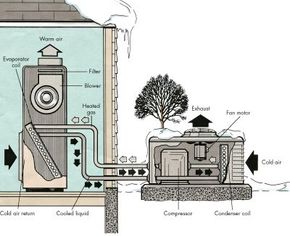A heat pump not only heats your home during the winter, it also cools it during the summer. It does not burn fuel to produce heat nor does the electricity it consumes go through an element. The heat pump functions on the same principle as refrigerators and air conditioners: A liquid absorbs heat as it turns into a gas and releases heat as it returns to a liquid state.
During the summer, the heat pump operates as a standard central air conditioner: It removes heat from the house and vents it to the outside. A liquid refrigerant is pumped through an evaporator coil of tubing. The liquid expands as it moves through the coil, changing to its gaseous state as it absorbs heat from the air surrounding the coil.
Advertisement
A blower then pushes air around the cooled coil through ducts and into the house. The gas, now carrying considerable heat, moves through a compressor and begins the liquefying process. It then moves to a condensor coil outside the house, where the compressed gas releases its heat and returns to a liquid state.
During the winter, the heat pump reverses this process, extracting heat from the cold air outside and releasing it inside the house. The heat pump is very efficient when the outside temperature is around 45 degrees Fahrenheit to 50 degrees Fahrenheit, but it becomes less efficient as the temperature drops. When the outside air temperature is very low, an auxilery electric heater must be used to supplement the heat pump's output.
Like standard electric heating systems, this auxilery unit is more expensive to operate. Thus, in areas where the winter temperature is below freezing, a heat pump is not practical. It has few advantages over conventional heating systems in areas where air conditioning is not necessary, but it is very efficient in warm to hot climates.
Heat pump maintenance is important. Small problems that are not addressed early can lead to very expensive compressor problems later. And since maintaining a heat pump is more technical than caring for the average heating system, you should call a professional service person when the pump malfunctions. You can, however, keep the system free of dirt by keeping the filter clean and by removing any other obstacles to the flow of air.
Proper outdoor maintenance of a heat pump is also important. Learn how to perform this type of maintenance in the next section.
Advertisement
